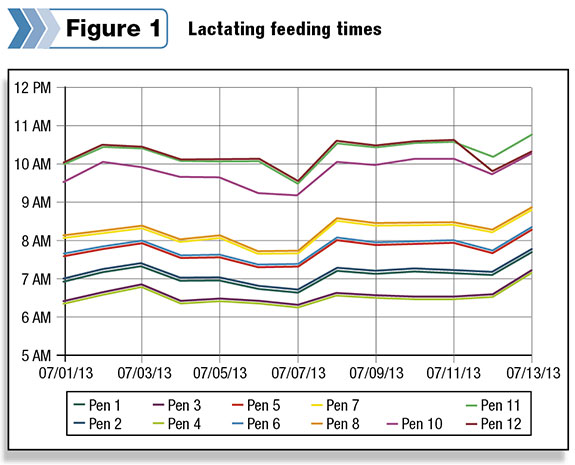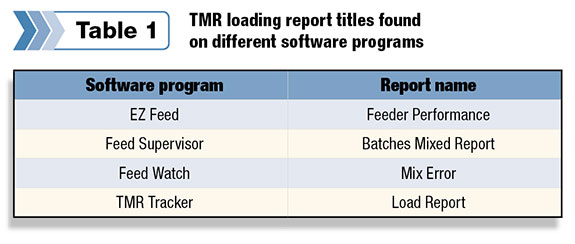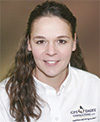Feed software programs have recently become more widely implemented and are utilized to gather and evaluate a tremendous amount of feeding-related information.
This year at the Four-State Nutrition Conference, GPS Dairy Consultants Jim Barmore and Marty Faldet, along with Feed Supervisor’s Keith Sather, participated in a panel discussion to talk about how they utilize feed intake data.
I’d like to share some of their ideas as well as provide some of my own experience in working with four different feed software programs.
There are numerous programs available in addition to those discussed here; these are simply the programs I have experience with on the dairies for which I currently consult.
The data provided by feed software programs tells the story of a herd’s daily dietary routine and can help us to understand how to help a feeder improve or become more efficient in their work.
This article will focus on how different reports can provide valuable information in the areas of ration management and feeder performance.
One of the first reports we evaluate is dry matter intake (DMI) per head over an extended period of time so we can quickly see peaks and valleys in DMI for specific pens.
To accurately evaluate and fully understand this measurement, it’s important to understand what affects the DMI calculation.
The calculation for DMI per head per day is affected by the following factors:
• Pounds of feed delivered to pen
• Dry matter percentage of ration delivered to pen
• Amount of recorded weighback removed from pen
• Number of animals in the pen
Probably the most commonly used DMI report is the seven-day rolling DMI report by pen, recipe, parity or average for all lactating cows.
This is a report that should be run as part of the feed team’s weekly information and shared with the nutritionist, owner, herdsman and veterinarian.
With certain software programs, such as EZ Feed and Feed Supervisor, there are reports that include several associated items together on one page: DMI target, actual DMI, adjustment or change from previous day’s target, weighback (as both percentage and pounds), pen count and earliest unload time.

Earliest unload time is what time the first feed drop of the day is delivered to a given pen (see Figure 1 ).
It’s good to review this report periodically to be certain the feeder is getting TMR to cows in a timely, consistent manner.
Weighback values can be either loaded back into the TMR wagon and weighed or estimated and hand-entered into the system.
Changes in weighback can be influenced by the time first feed is dropped to the pen.
If the feeder delivers TMR two hours late to a group of cows, they will have two extra hours to consume yesterday’s feed, and the weighback will be much less.
Thus, the current day’s DMI will be low, and the previous day will show high DMI.
Evaluation of weighback amounts is a good way to bring awareness to the entire dairy team around the importance of everyone’s role in cow health and productivity with regard to the feeding program.
Several feed-related tasks are often shared among the dairy team: Cow pushers also push up the TMR, the herdsman is responsible for communicating pen moves, and night milking crews know about what time a given feedbunk went empty.
Less than 5 percent occurrence of zero weighback for all pens in a month is the goal that consultant Jim Barmore has set for his high-producing herds.
For example, if a herd has six pens of cows to feed, there can be no more than nine zero-bunk reads for a 30-day period [(6 pens x 30 days) x 0.05] = 9. Reports such as the Clean Up Tracking Report (Feed Supervisor) and Refusal Summary (EZ Feed) should be reviewed monthly with the team.
Keith Sather described a graph in Feed Supervisor that includes herd daily DMI with milk production per cow and clean-up percentage that can provide a quick evaluation of the dairy’s ration management.
Another major benefit of feed software programs is the information provided in the form of ingredient loading and delivery accuracy of the feeder.
Many of the systems allow the user to choose which recipes, ingredients, feeders and mixers to evaluate and to set what error tolerance will trigger an alert.
Marty Faldet uses this report when sitting down with the feeder to discuss ration consistency from a loading accuracy standpoint. He likes to see deviations less than 100 pounds as-fed for forages and 50 pounds as-fed for dry commodity ingredients.
The load report has become one that many of the feeders I work with look forward to reviewing because it provides useful, tangible feedback on how they are doing. Although running this report monthly provides good feedback, it can get to be too many loads to review and remember.
I like to go through the data once a month and print off 15 to 20 fairly recent loads that are indicative of the normal trends to review with the feeders.
By including feed costs in this report, the members of the feed team can discuss specific loads where deviations were large and realize with more awareness the dollars associated with those deviations.

The load report can also help the nutritionist determine if a specific ingredient is difficult to load accurately or if split loads are hard to deliver consistently.
The reports for the specific programs are in Table 1 .
There are many benefits to evaluating the information provided from feed software programs with your feed team; to gain the most from the system, it should be used for more than entering rations and providing feeders with electronic batch sheets.
These programs are an invaluable tool in moving our feeding programs from average to exceptional.
One in which engaged employees can realize their role in creating a healthy, productive environment for the cows so that your dairy business can reach its most challenging goals. PD
Sarah Daugherty has a master’s degree in animal nutrition. She has nine years of experience in dairy nutrition and management consulting and is the owner of Daugherty Consulting, LLC as an independent agent of GPS Dairy Consulting, LLC.

Sarah Daugherty
Independent Consultant
GPS Dairy Consulting, LLC





